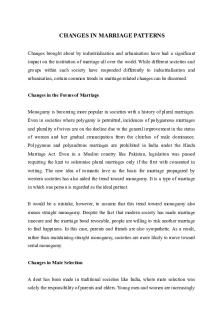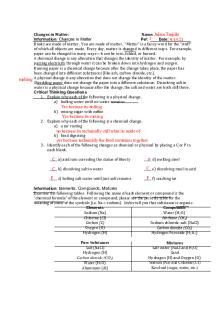PSY358-RS-Cognitive Changes PDF

| Title | PSY358-RS-Cognitive Changes |
|---|---|
| Author | Sean Rogers |
| Course | Adult Development and Aging |
| Institution | Grand Canyon University |
| Pages | 4 |
| File Size | 228.5 KB |
| File Type | |
| Total Downloads | 10 |
| Total Views | 140 |
Summary
Complete topic 2 worksheet with all answers and more than the required amount of references...
Description
PSY-358 Adult Development and Aging Topic 2 – Cognitive Changes during Adulthood Directions: This assignment will require you to type directly in this worksheet. Part I will require you to research cognitive related changes during adulthood. In each box, describe 3-4 cognitive changes that generally occur during that age-range (include things such as memory, attention, structural change, processing speed, executive functioning, and neurotransmission). Part II, requires that you answer the follow-up questions. Please delete the examples in red. A minimum of three resources are required. Your textbook may serve as one resource. Make sure the references are current and cited both with your chart and referenced in the reference section. Part I: General Cognitive Changes Age Range Emerging Adulthood through Early Adulthood (approx. 17-25-ish)
Brain Development/Cognitive Changes EXAMPLES: The prefrontal cortex is still developing, which influences reasoning, judgement, and problem solving … The limbic system, which serves as the reward system (e.g. linked to risk taking)... Synaptic pruning… Neurocircuitry continues to strengthen and contributes to problem solving skills. It also increases the ability to multitask with increases in attention. (Arain et al., 2013) The brain rewires itself from puberty until the age of 24 with the prefrontal cortex becoming more efficient in information processing. (Arain et al., 2013) This contributes to reasoning and improvements in judgement leading to less risky behavior as compared to adolescence. Cortical white matter increase into the mid-twenties. The increases efficiency of cortical connectivity and an increase the ability to retain and learn new information (Hochberg & Konner, 2019)
Early Adulthood Through Middle Adulthood (25-45-ish)
Brain activity begins to diminish in the prefrontal and temporal areas of the brain. These areas support functions like memory. (Cavanaugh, & Blanchard, 2019). Structural changes create a decline in the number of neurons. (Cavabaugh & Blanchard, 2019). Additionally, a decrease in the number of dendrites, tangles in neurofibers, and deposits of protein occur as well. (Cavabaugh &
Blanchard, 2019).
Middle Adulthood through late adulthood (45-ish through death)
Cognition begins to stabilize peaking around age 35. This contributes to the ability to examine questions from multiple angles and no longer view things as just right or wrong. (Boundless, n.d.) Plasticity continues through middle age and the brain is still capable of rewiring itself. With a combination of life experiences, a middle-aged individual is calmer, less neurotic, and more adapt at social situations. (Phillips, 2011) Processing speed begins to decline but the ability to complete objectives remains intact. (Phillips, 2011) Verbal and spatial reasoning continue to improve along with abstract reasoning. (Phillips, 2011) White matter continues to shrink as age increases. This shrinkage in the hippocampus and contribute to the development of Alzheimer’s disease. (Cavabaugh & Blanchard, 2019)
Part II: Follow-up Questions In 150-250 words, please answer the following questions:
During what age range do we see the most dramatic cognitive changes occurring? Cognitive functions remain stable until around the age of 60-70, but most cognitive decline happens after 70. (Salthouse, 2009) Cognitive functions will continue to increase until early midlife and will then experience a plateau. (Salthouse, 2009) When decline occurs, it begins initially at a slow pace and then rapidly increases. Initial changes to cognition can be influences by changes in life including menopause or retirement. A decrease in activity or age-related diseases could contribute to this as well.
Choose (and explain how) at least two factors that might exacerbate the cognitive changes above. High risk behavior such as binge drinking can affect cognition long term. Neuroimaging studies demonstrate impaired brain development and a reduction in white matter integrity in adolescents. (Waszkiewicz et al., 2018) In a dose-response analysis, it was determined that there is an elevated risk of developing dementia when over 38g of alcohol is consumed regularly. Additionally, a reduction in hippocampal response can create an impairment with visual and linguistic processing. (Waszkiewicz et al., 2018) Another factor that might affect cognitive changes over time is excessive drug use. Specifically, a drug such as methamphetamine reduces the binding of dopamine. A reduction in dopamine can contribute to behavioral changes and make it difficult for an individual to experience pleasure. Additionally, microglia can be damaged. Microglia help to defend the brain against infectious agents
helping to remove neurons that are damaged. Neuron death can occur throughout the brain and prolonged use can contribute to impaired learning and motor skills. Even after the substance is no longer abused, the damage can be permanent. Dopamine receptors can begin to bind again, but can often take years to repair themselves.
Examples: Lack of sleep, binge drinking. What can be done to offset some of these cognitive changes (chose one example from your chart and include both preventive and accommodating ideas/tips). Examples: Nutrition and creativity. A solution for a behavioral change resulting in the cessation of binge drinking could include seeking therapy. Developing coping skills can help an individual deal with stressors presented in life and remove drinking as the solution to problems. Another replacement activity would be to develop a routine each day that focuses on healthy nutrition and exercise to help replenish dopamine and reverse the damage done by the sugar present in alcohol. In addition, an individual can utilize support groups to help develop a purpose and relate their experiences to other individuals. Cessation of binge drinking may not reverse all of the negative cognitive effects, but it can help stop further damage to the brain.
What was your biggest take-away from this activity? What changes might you make now? My biggest take away from the assignment is how much external stimuli can affect an individual’s cognitive development. I have always believed that cognitive development and decline were mainly determined by genetics, but to know that behavior can impact it so dramatically is surprising. In addition, I thought it was interesting to learn that cognition drastically declines after the age of 70. When I examine the decline of my grandmother, her dementia came on suddenly and rapidly became worse which was difficult for me to understand. Moving forward, I will continue to examine my behavior and not rely on my genetics to determine my cognitive decline in the future. I will focus on maintaining my health now instead of waiting to make changes when a problem presents itself.
References: Arain, M., Haque, M., Johal, L., Mathur, P., Nel, W., Rais, A., . . . Sharma, S. (2013). Maturation of the adolescent brain. Retrieved November 02, 2020, from https://www.ncbi.nlm.nih.gov/pmc/articles/PMC3621648/ Boundless. (n.d.). Boundless Psychology. Retrieved November 02, 2020, from https://courses.lumenlearning.com/boundless-psychology/chapter/early-and-middle-adulthood/ Hochberg, Z., & Konner, M. (2019, December 17). Emerging Adulthood, a Pre-adult Life-History Stage. Retrieved November 02, 2020, from https://www.frontiersin.org/articles/10.3389/fendo.2019.00918/full Phillips, M. (2011, April). The mind at midlife. Retrieved November 02, 2020, from https://www.apa.org/monitor/2011/04/mind-midlife
Salthouse, T. (2009, April). When does age-related cognitive decline begin? Retrieved November 02, 2020, from https://www.ncbi.nlm.nih.gov/pmc/articles/PMC2683339/ Waszkiewicz, N., Galińska-Skok, B., Nestsiarovich, A., Kułak-Bejda, A., Wilczyńska, K., Simonienko, K., . . . Konarzewska, B. (2018, July 04). Neurobiological Effects of Binge Drinking Help in Its Detection and Differential Diagnosis from Alcohol Dependence. Retrieved November 02, 2020, from https://www.hindawi.com/journals/dm/2018/5623683/...
Similar Free PDFs

Accounting Changes
- 43 Pages

Physical and Chemical Changes
- 2 Pages

PSY358-RS-Cognitive Changes
- 4 Pages

Changes IN Marriage Patterns
- 4 Pages

Exploring Chemical Physical Changes
- 10 Pages

Changes in Matter
- 4 Pages

ICD10 Changes October 2018
- 1 Pages

Phase changes pogil - idek
- 9 Pages

Apush 1920s Changes Paper
- 2 Pages

Bitesize Notes - Chemical Changes
- 57 Pages

Phase changes worksheet
- 2 Pages

Changes in the land
- 2 Pages

Changes by Tupac notater
- 8 Pages

Gizmo Chemical Changes SE
- 12 Pages
Popular Institutions
- Tinajero National High School - Annex
- Politeknik Caltex Riau
- Yokohama City University
- SGT University
- University of Al-Qadisiyah
- Divine Word College of Vigan
- Techniek College Rotterdam
- Universidade de Santiago
- Universiti Teknologi MARA Cawangan Johor Kampus Pasir Gudang
- Poltekkes Kemenkes Yogyakarta
- Baguio City National High School
- Colegio san marcos
- preparatoria uno
- Centro de Bachillerato Tecnológico Industrial y de Servicios No. 107
- Dalian Maritime University
- Quang Trung Secondary School
- Colegio Tecnológico en Informática
- Corporación Regional de Educación Superior
- Grupo CEDVA
- Dar Al Uloom University
- Centro de Estudios Preuniversitarios de la Universidad Nacional de Ingeniería
- 上智大学
- Aakash International School, Nuna Majara
- San Felipe Neri Catholic School
- Kang Chiao International School - New Taipei City
- Misamis Occidental National High School
- Institución Educativa Escuela Normal Juan Ladrilleros
- Kolehiyo ng Pantukan
- Batanes State College
- Instituto Continental
- Sekolah Menengah Kejuruan Kesehatan Kaltara (Tarakan)
- Colegio de La Inmaculada Concepcion - Cebu

